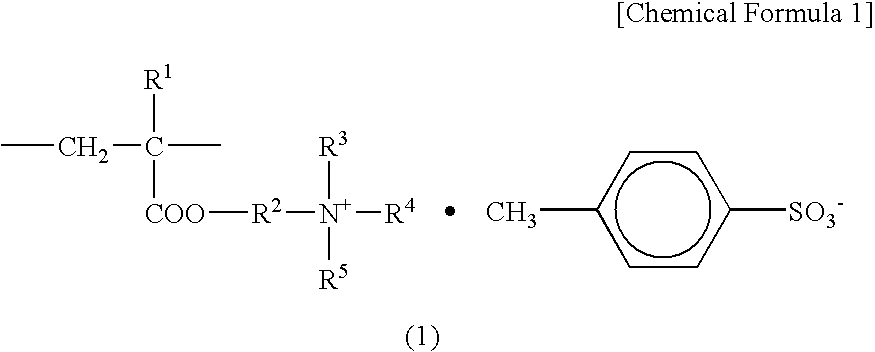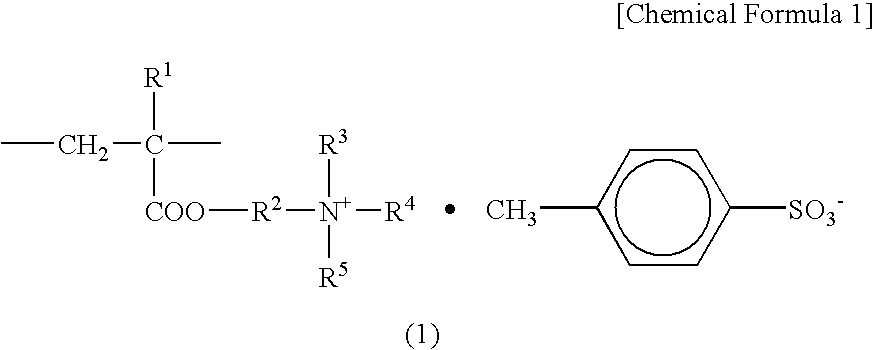Positive charge controlling agent, process for producing the same, and electrophotographic toner containing the same
a technology of positive charge controlling agent and process, applied in the field of electrophotographic toner, can solve the problems of low chargeability and colorability of obtained positive charge controlling agent, low chargeability and colorability, and color tone may be affected, so as to prevent discoloration, excellent chargeability, and compatibility with and dispersibility of binder resin.
- Summary
- Abstract
- Description
- Claims
- Application Information
AI Technical Summary
Benefits of technology
Problems solved by technology
Method used
Image
Examples
example 1
Production of Positive Charge Controlling Agent
[0064]A 2-liter flask equipped with a stirrer, a condenser, a thermometer, and a nitrogen introducing tube was charged with 180 g of isobutanol as the reaction solvent, and 18 g of diethylaminoethyl(meth)acrylate and 18 g of methyl paratoluene sulfonic acid were added thereto. The mixture was stirred for 1 hour at 80° C. under a nitrogen atmosphere to subject a quaternization reaction. Thereafter, 210 g of styrene, 72 g of butylacrylate, and 12 g of t-butylperoxy-2-ethylhexanoate (produced by ARKEMA YOSHITOMI, LTD.) which serves as a peroxide-based initiator, were added while introducing nitrogen, the mixture was heated to 95° C. (polymerization temperature), and stirred for 3 hours. To this reaction solution, 6 g of t-butylperoxy-2-ethylhexanoate was further added, and the mixture was stirred for 3 hours to obtain a polymer solution.
[0065]The polymer solution was dried with heating under reduced pressure (initial temperature of 140° C....
examples 9 and 10
[0092]Positive charge controlling agents and toners were obtained in the same manner as in Example 1. However, for Example 9, the copolymerizing ratio of monomers, (M1)+(M2):(M3), was changed to 98.7:1.3, using 18 g of diethylaminoethyl(meth)acrylate, 2 g of methyl paratoluene sulfonic acid, and 242 g of styrene.
[0093]For Example 10, the copolymerizing ratio of monomers, (M1)+(M2):(M3), was changed to 71.7:28.3, using 45 g of diethylaminoethyl(meth)acrylate, 45 g of methyl paratoluene sulfonic acid, and 156 g of styrene.
[0094]With regard to these obtained agents and toners, various measurements and evaluation were carried out as in Example 1. The results are shown in Table 1.
PUM
| Property | Measurement | Unit |
|---|---|---|
| half-life temperature | aaaaa | aaaaa |
| glass transition temperature | aaaaa | aaaaa |
| mean particle diameter | aaaaa | aaaaa |
Abstract
Description
Claims
Application Information
 Login to View More
Login to View More - R&D
- Intellectual Property
- Life Sciences
- Materials
- Tech Scout
- Unparalleled Data Quality
- Higher Quality Content
- 60% Fewer Hallucinations
Browse by: Latest US Patents, China's latest patents, Technical Efficacy Thesaurus, Application Domain, Technology Topic, Popular Technical Reports.
© 2025 PatSnap. All rights reserved.Legal|Privacy policy|Modern Slavery Act Transparency Statement|Sitemap|About US| Contact US: help@patsnap.com


